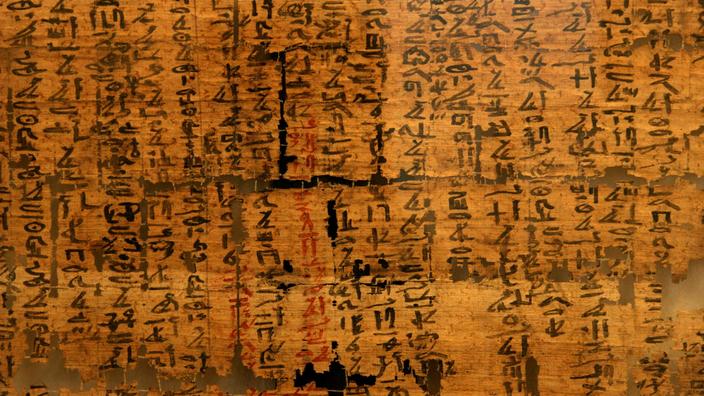It is one of the most important sources on ancient Egyptian medicine: the two fragments of the Louvre-Carlsberg papyrus, preserved more than 1000 km from each other, formed the same medical treatise, badly damaged, with an unfolded length of six meters.
Studied since 2018 by a Franco-Danish team from the Louvre and the University of Copenhagen, the text, particularly tricky to decipher, has just been the subject of a complete translation which lifts the veil on the last mysteries it concealed. again.
Read also: In Egypt, the mummy of a pharaoh reveals his secrets thanks to science
"
This text provides a number of important details on what happens inside an embalming workshop, on who does what and who designs what
" explains Marc Étienne, curator at the Egyptian Antiquities Department of the Museum. of the Louvre.
Written around 1450 BC.
AD, around the beginning of the Egyptian New Kingdom (1539-1077 BC), the treatise - composed of papyrii pLouvre E 32847 and pCarlsberg 917 - dealt with subjects as diverse as the tests of pregnancy, herbalism, treatment of skin diseases, tumors, abscesses.
A “
not very inviting
”
sum
- as the Louvre curator
jokes
- made even more fascinating by the inclusion of a “manual” devoted to the embalming of the dead, certain exact procedures of which are still little known to Egyptologists.
New details on embalming
One of these "
lost secrets
" concerned the embalming of the face: "
We discovered a list of ingredients for the realization of a remedy composed largely of aromatic substances and vegetable resins cooked in a liquid, with which the embalmers coat a piece of red linen,
detailed in a press release the Danish researcher Sofie Schiødt who has just defended her thesis on the papyrus.
This red linen is then applied to the face of the deceased in order to cover it in a protective cocoon of odorous and antibacterial materials. "
"
We knew that we could put stamps on the face, but the text corroborates and clarifies what we had observed in the archaeological excavations
" specifies Marc Étienne.
Artist's impression of the facial embalming process.
This was covered with a piece of red linen and aromatic substances.
Ida Christensen
Another discovery, which will delight numerology enthusiasts, was the division of the different stages of embalming into periods of four days.
If the operation thus stretched over 70 days - which we already knew from Herodotus - it was articulated in 17 sequences of four days, punctuated by as many apotropaic processions.
A sort of “
rotation
” that is still poorly understood.
“
It's quite special to grasp.
Is it directly related to the work of the embalmer, or is it related to the periodicity of the products that are to be produced?
Asks the curator of the Louvre.
In all cases,
"the mummy being completed on the 68th day, it was placed in its coffin, after which the last days were devoted to ritual activities allowing the deceased to continue living in the afterlife,"
said Sofie. Schiødt.
Read also: The sulphurous Bible museum in Washington returns thousands of missing antiquities to Egypt
If this is not the first "manual" discovered on mummification, the "
extremely detailed
"
precision
of the text surprised the Egyptologists who studied the hieratic characters of the papyrus, with regard to the very disparate elements at their disposal. until then in more recent sources.
As the Danish Egyptologist explains, "
many descriptions of the embalming techniques that we find in this papyrus have been omitted in the last two manuals
.
"
"All this documentation is very rare",
underlined in 2018 Kim Ryholt, head of the Carlsberg papyrological collection at the University of Copenhagen.
“
There are less than a dozen well-preserved ancient Egyptian medical papyri ... Anything new would necessarily be very enlightening.
"
"The text reads like a memory aid, so the intended readers must be specialists who need to be reminded of these details, such as the ointment recipes and the use of various types of dressings."
Egyptologist Sofie Schiødt
Once deciphered, the papyrus was also quite clear, a thousand miles from the convoluted turns and opaque allusions on which epigraphists sometimes have to work.
"The text reads like a memory aid, so the intended readers should be specialists who needed to be reminded of these details, such as the ointment recipes and the use of various types of dressings,"
he said. esteemed Sofie Schiødt.
“
Some of the simpler processes, such as drying the body with natron, have been omitted from the text.
"
The Louvre-Carlsberg papyrus had been the subject of a first partial translation in 2018, carried out by Thierry Bardinet.
The result of a long-term collaboration between the Louvre Museum and the University of Copenhagen, the first full scientific edition of the document is expected in 2022.












/cloudfront-eu-central-1.images.arcpublishing.com/prisa/KMEYMJKESBAZBE4MRBAM4TGHIQ.jpg)


